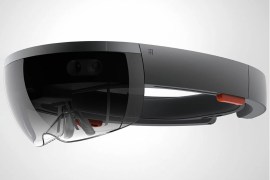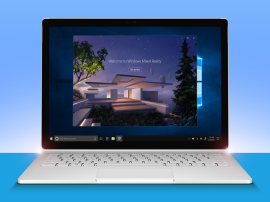Want to develop for HoloLens? Apply now (but have $3000 handy)
Developer kits arriving in early 2016

Instead of saving the most exciting stuff until last, Microsoft decided to go straight for the jugular by opening its 2016 devices event with HoloLens. It looks amazing.
Using a special camera that allows us proles to see what the chap on stage can see through the HoloLens goggles, we saw the stage turn into a battle zone as robotic aliens virtually smashed through the physical walls and started firing at our human demoer.
But Project Xray isn’t virtual reality; it’s “mixed reality”, which means our guy was able to hide behind the sofa to avoid being hit. And he could, of course, fire back. Activating his weapon made a Metroid-like blaster surround his fist, and he could use this to fire lasers at the little blighters hovering in the air.
The interaction between the real and the virtual looked pretty seamless through the video feed, with the holes in the walls looking alarmingly real. Through them you could see into space.
This was clearly more tech demo than finished product, but as a taster of what HoloLens can bring to gaming it was compelling to say the least.
But when will it be available?
When can you buy one? If you’re just an average gadgeteer, we still don’t know. Launch dates for the consumer version weren’t mentioned.
But if you’re a developer, you can apply for one now. Yep, that’s "apply" not order, so you need to match certain criteria (including being in the US or Canada) in order to be allowed to buy one.
Pass the test and you’re in… as long as you’ve also got $3000 spare. Ouch.
Does that mean the consumer edition will also cost thousands of dollars? Only time will tell, but it’s interesting to compare to Oculus Rift, developer kits of which cost just $350.
As Microsoft were keen to remind everyone, HoloLens is fully untethered, which means that – unlike Oculus Rift, Vive or PlayStation VR – it doesn’t need to be connected to a separate computer, console or phone. Presumably that means it needs lots of powerful, advanced hardware onboard, and that could clearly whack the price up.
Hopefully we’ll get more news about the consumer version once developer kits are out in the wild in early 2016, but colour us excited in the meantime.



